Pan-Seared Wild Duck Breast with Port Wine Reduction
This post may contain affiliate links. Please read my disclosure policy.
Seared Duck Breast with Port Wine Reduction — it’s a dish fit for a bistro menu. Truly, the sauce tastes as if it took hours to prepare, as if pans loaded with veal bones had to be roasted, as if those bones then had to simmer into a rich stock, and as if that stock had to reduce to a syrup.
It’s the sort of sauce that elicits comments such as, “I could bathe in this.” I promise you, anyone could make this sauce. It’s foolproof.
The sauce, incredibly, has only three ingredients — port wine, shallots and chicken stock. Admittedly, a 750-ml bottle of port — cheap port but port nonetheless — gets reduced by more than half. And making it does require a bit of love, by which I mean time, about an hour total.
This is not a sauce you want to casually dip your grilled burger into (as fantastic as that sounds). It’s a sauce you want to reserve for a special occasion, perhaps a date night at home?
It’s certainly a good recipe to have in your repertoire. Moreover, it comes from Sally Schneider’s A New Way to Cook, one of my all-time favorite cookbooks. The spice rub recipe, a mixture of orange zest, thyme, salt, pepper and sugar, is a must-know as well. It’s simple yet critical for tenderizing the meat and imparting a subtle orange flavor, which complements duck so well.
Until about a month ago, when my husband returned from a duck hunting trip at Pine Island in Louisiana, I hadn’t cooked a duck breast in years. Duck is so yummy! I had forgotten. It has been such a treat having such incredibly tasty meat on hand. And while these breasts hardly need additional seasoning, the spice rub and sauce transform a simple seared piece of meat into a bistro-style entrée.
Unfortunately, I can’t prescribe a foolproof method for cooking the duck breasts. With a poor ventilation system and a smoke detector located just inches from our kitchen, we’ve developed a cooking method that foremost prevents the house from burning down. We start the breasts stovetop in a cast iron skillet and finish them in a 450ºF oven, flipping them once, cooking them no more than five minutes total.
When the breasts are resting, we finish reducing the sauce, pour some wine, and prepare for date night at home. It’s fun. I think you’d enjoy it, too.
The husband, surrounded by dogs, never happier:
Some good southern cooking — fried soft shell crabs, fried oysters, fried shrimp. Apparently there were some incredible biscuits, too. I’m just a little jealous.
The rub — a mix of orange zest, thyme, salt, pepper and sugar — for the duck breasts.
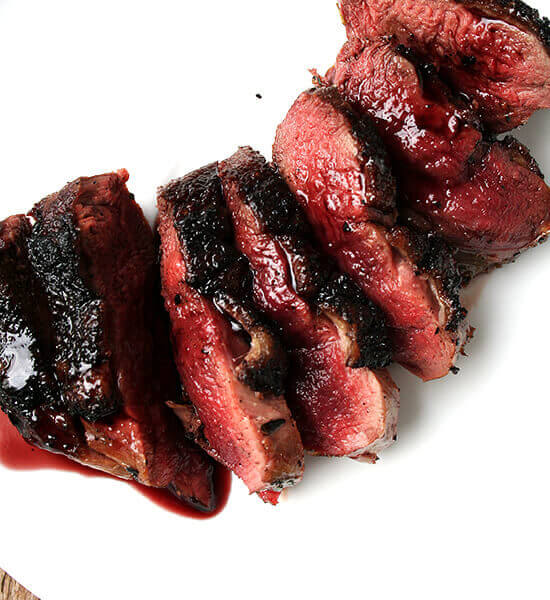
Pan-Seared Wild Duck Breast with Port Wine Reduction
- Total Time: 4 hours 5 minutes
- Yield: 2
Description
Adapted by Sally Schneider’s A New Way to Cook
Notes: I cannot give you a foolproof way of cooking your duck breasts. I’ve described what we do below to yield a perfectly medium-rare duck breast from our kitchen, but every piece of meat is different, every oven is different, every pan is different, etc. There are so many factors and truthfully, we ruined several duck breasts before we figured out just how to get it right. The rub and the sauce recipes below, however, are simple and foolproof.
Ingredients
The Rub
- 1/4 teaspoon fresh thyme leaves
- 1/2 teaspoon grated orange zest (I use the zest of one whole orange)
- 1/4 teaspoon sugar
- 1/2 teaspoon fresh ground pepper
- 1/2 teaspoon kosher salt
- 2 duck breasts*
- Port wine sauce (recipe below)
*Schneider recommends boneless Moulard or Muscovy duck breast halves (3/4 to 1 pound each) or 4 boneless Pekin duck breast halves (about 6 ounces each). She also recommends removing the fat, which I have to disagree with — I think the fat adds nice flavor and helps protect the meat during the cooking process.
Instructions
- Schneider’s recipe calls for a mortar and pestle or a spice grinder because she started with whole peppercorns and allspice berries. I simply stir my salt, freshly ground pepper, sugar, zest and thyme in a small bowl. It works just fine. The mixture should look like sand.
- Place the duck breasts on a platter and rub the spice mixture into them. Cover with plastic wrap and refrigerate for at least 4 hours or overnight. About 20 minutes before cooking, remove the duck breasts from the refrigerator and return to room temperature. Preheat the oven to 450ºF. Pat dry with paper towels. With a paring knife, remove the tenderloin, the thin strip of meat that runs lengthwise down the underside of each breast.
- Heat a cast iron skillet over high heat. When the pan is hot — it doesn’t have to be smoking — put the duck breasts in fat side down. Let the breasts sizzle for about a minute (or longer if your kitchen isn’t getting too smoky) or a minute and a half, then place the pan in the oven. After two and half minutes total have passed, open the oven, flip the breasts over, close the oven and cook for another two to two and a half minutes. Remove the pan from the oven, transfer the breasts to a platter, and let rest for five minutes. Turn your oven off.
- While the breasts are resting, finish reducing the sauce. (See my notes below with the sauce recipe — I make the sauce a day in advance, and then heat as much as I think we need for the two of us while the breasts are resting.) Place your sauce in a small sauce pan or frying pan and heat over medium-high heat. In no time, the sauce should start to thicken up, at which point you should remove the pan from the stovetop. Slice the breasts, if desired, and pour your beautiful sauce over top. (Or, don’t slice the breasts, just pour the sauce over top.)
- Prep Time: 4 hours
- Cook Time: 5 minutes
- Category: Duck
- Method: Stovetop/Oven
- Cuisine: French
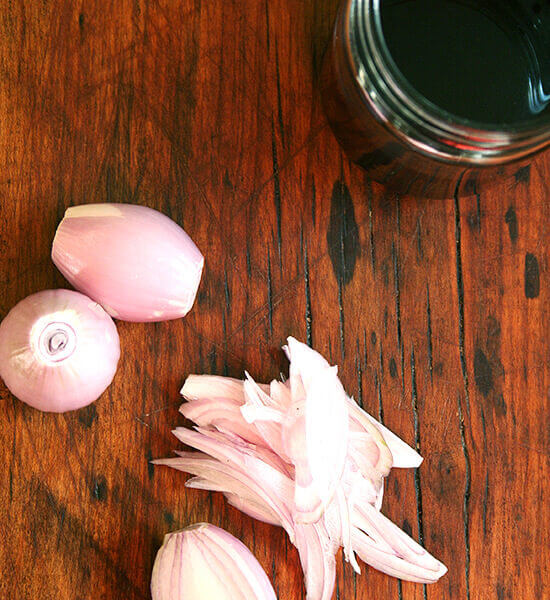
Port Wine Reduction Sauce
- Total Time: 50 minutes
- Yield: 2/3 cup
Description
Notes: I make the sauce a day in advance and in the final reducing phase, I only reduce it to about a cup versus a half cup. Then, when I am serving the duck, since it is usually just for my husband and me, I pour about a half cup of the sauce into a sauce pan and reduce that amount to a syrup, which is more than enough for two servings. And then, on a subsequent night, I have more sauce with which to do the same thing. Am I making sense? Please contact me if you have questions.
Ingredients
- One 750-millilter bottle Ruby Port (I couldn’t find Ruby Port, so I just bought the cheapest port I could find at the grocery store.)
- 2 shallots, thinly sliced
- 1/2 cup unsalted homemade or canned low-sodium chicken stock
Instructions
- In a heavy medium saucepan, combine the port and shallots and bring to a gentle boil over moderately low heat. Cook until the port has reduced to 1 cup, about 30 minutes.
- Strain into a small saucepan and add the chicken stock. Bring to a boil, reduce the heat to a simmer, and cook until reduced to about 1/2 to 2/3 cup, about 15 minutes longer. Serve hot.
The sauce will keep up to 1 month refrigerated in a tightly closed jar.
- Prep Time: 5 minutes
- Cook Time: 45 minutes
- Category: Sauce
- Method: Stovetop
- Cuisine: French
This post may contain affiliate links. Please read my disclosure policy.

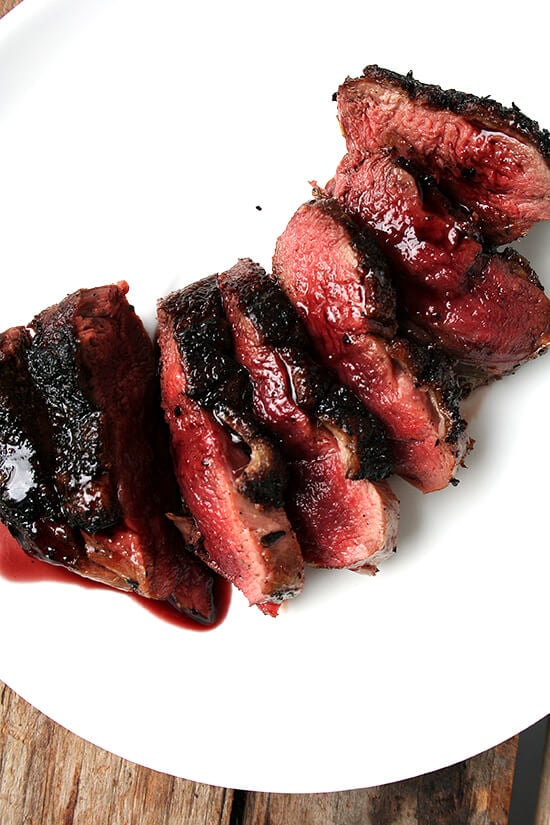
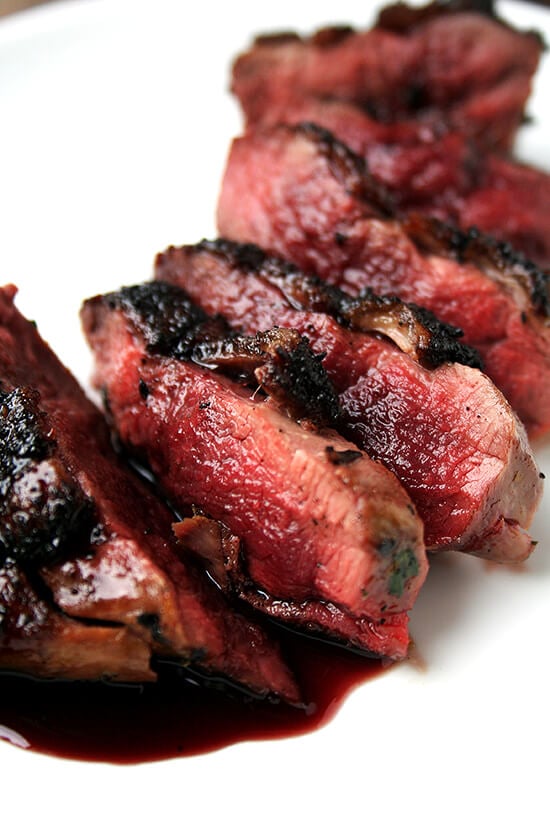




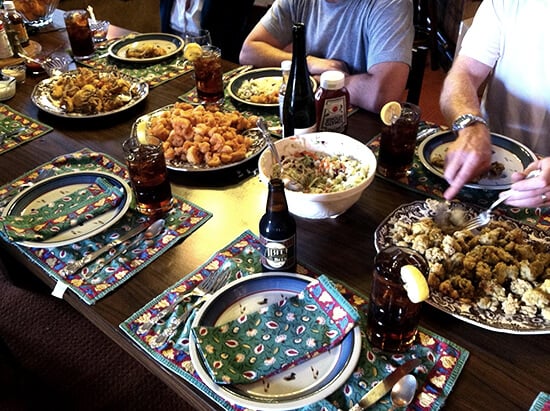

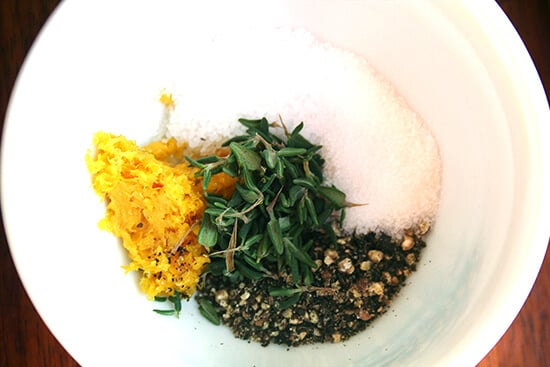
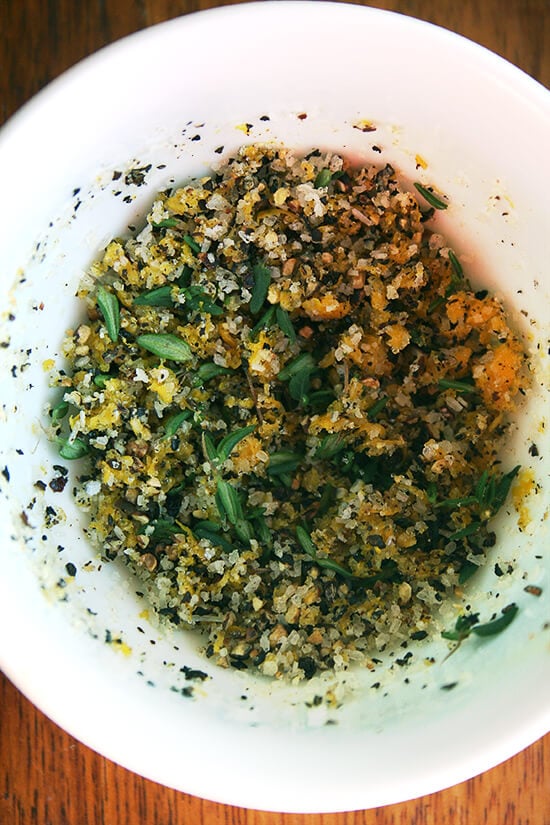
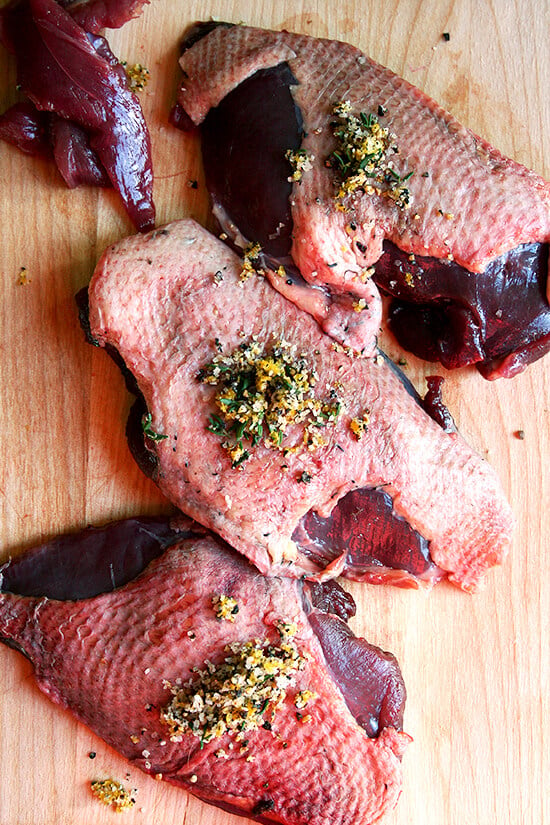
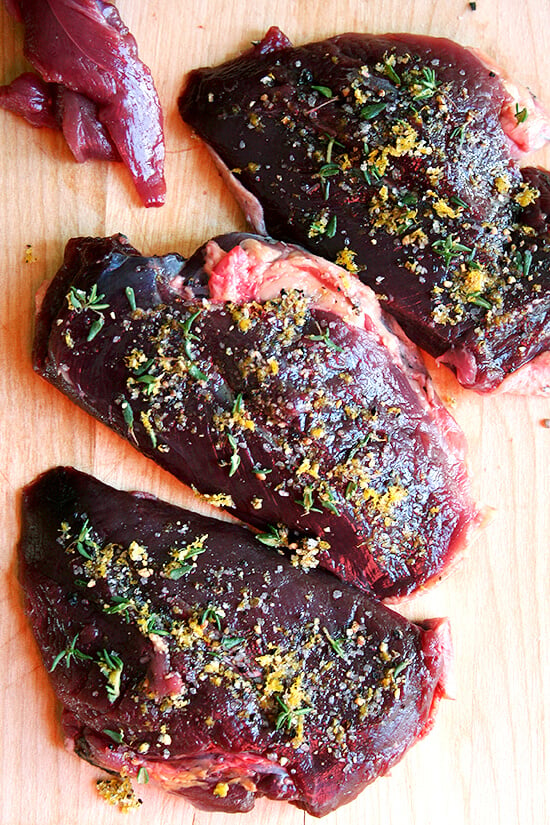
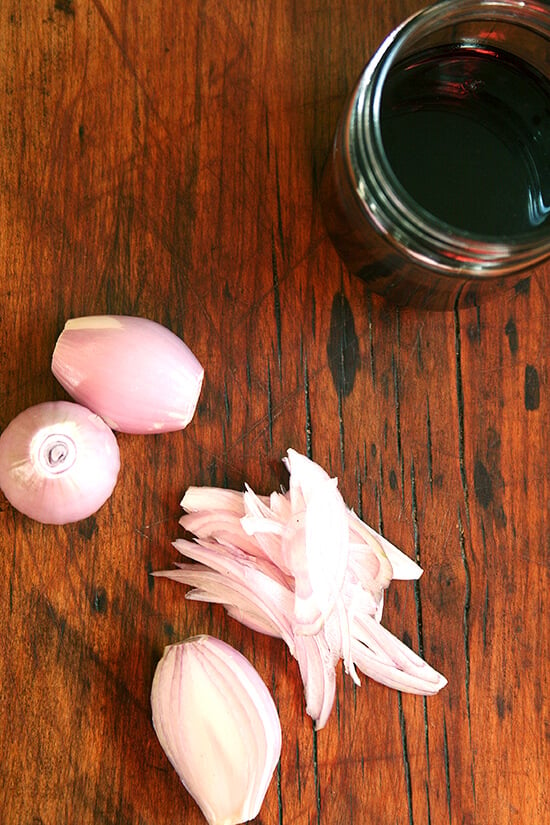
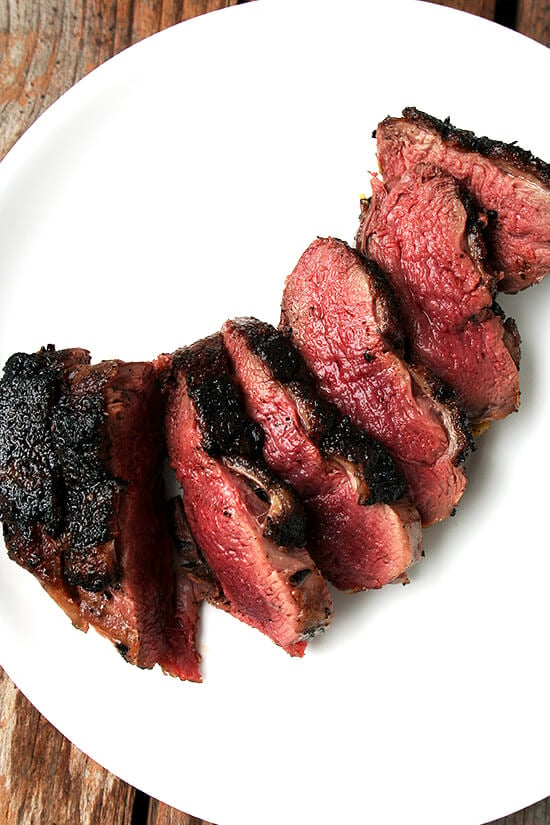
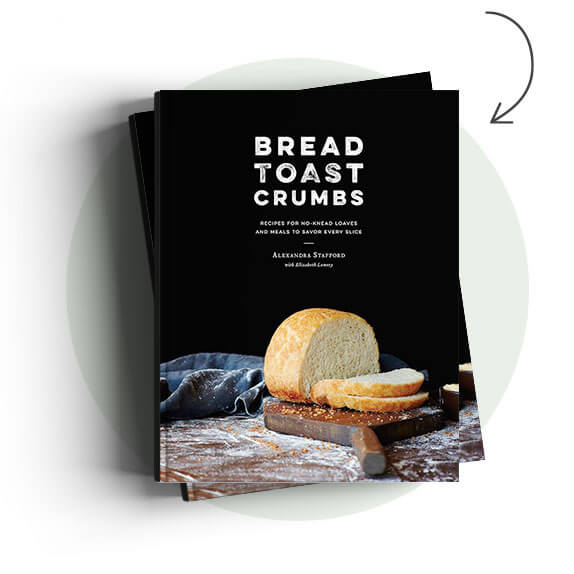

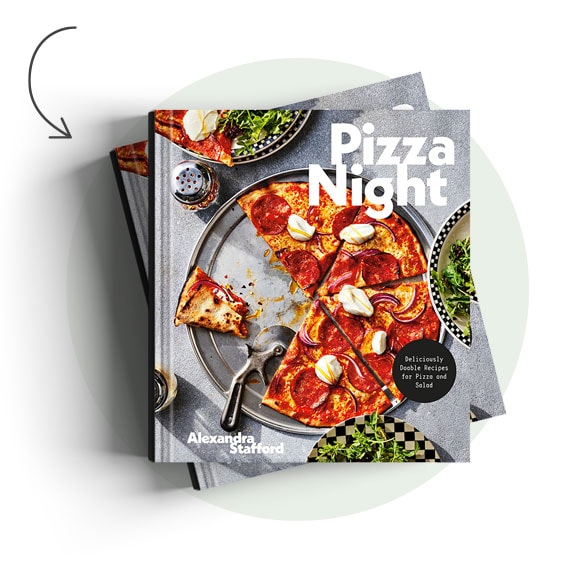
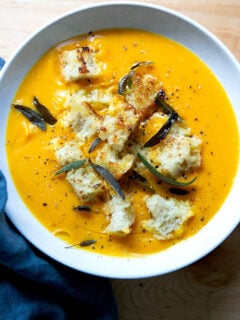
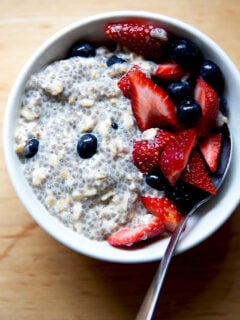
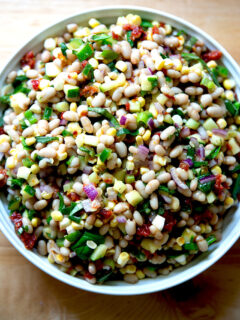
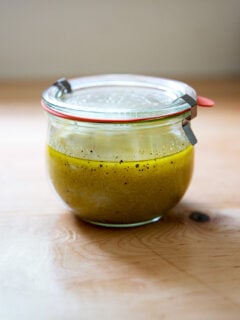
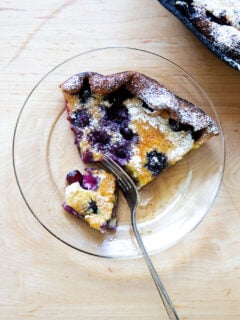
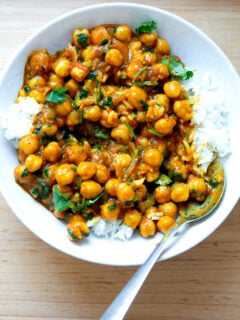



55 Comments on “Pan-Seared Wild Duck Breast with Port Wine Reduction”
I’m so excited about this recipe! We’ve just moved to the Dominican Republic and are thrilled to have seen beautiful duck in the grocery store yesterday. This just may be our first meal in our new home in a few short days….Happy Holidays and thanks for all the wonderful recipes and commentary. We check your blog weekly.
Thanks Elizabeth — you are nice to say such things. Hope you give the duck a try! I wish we had access to duck in our stores… our freezer supply is nearly out. Happy Holidays to you as well!
perfect timing. zach just informed me last week that he really likes duck (who knew???). with the sauce and the rub this sounds like a delicious meal. Um, and loved the Pine Island shots and the grass camo outfit!
So good to hear this Talley. I’m glad we’ll all be able to agree on dinner when you kidnap me 🙂
I love duck! And this looks wonderful! My dad is a big duck hunter, and I just love whenever duck season rolls around. This sounds like a recipe we may need to try soon!
Erin — Fun! Does your dad cook lots of his duck? We’ve discovered that you really cannot overcook this meat otherwise it gets a sort of livery taste. Just wondering if you’ve experienced the same. Hope you do try the recipe sometime. The sauce is sooooo good!
Yum! I love duck too. My Dad and Brother both hunt, so maybe I’ll pass this along!
My husband hunts too so last week I had him filet some duck with skin on, bone out.
It was delicious. The only ( evil) secret I added was a pat of butter into the sauce just before serving….awesome! The rub was delicious and the sauce would be great with any red meat game….elk, caribou,venison…I bet even boar would go well with it.
Bravo!
I love this recipe, and I’m lucky to get fresh duck locally. Question: is there a reason the rub is sort of piled to the center on the skin side rather than rubbed all over the skin?
Oh, and a small thing that seems to help: after I put the breast skin down in the baking pan, I pour the hot duck fat from the pan onto the other side. It seems to bring out more of the orange flavor.
Hi Anders! I’m so happy to hear that you like this, and thank you for the tip in regard to pouring the duck fat onto the other side of the duck. Your comment couldn’t have come at a more perfect time — my husband literally just returned from another Pine Island Hunting trip, and we have a freezer full of duck breasts. Where do you live? I am jealous of your local duck.
And, that picture is misleading. I must not have snapped a photo of it rubbed all over. So, definitely rub it all over. I was just divvying the seasoning up I suppose.
Hi Alexandra!
I’m making this for my fiancé’s birthday tomorrow and I’m doing the grocery run this afternoon. Quick question – what did you serve it with? Scalloped potatoes? I’m worried this might be too heavy if there is the port reduction sauce – would steamed potatoes be a nice accompaniment to soak up some sauce? And talking greens…. would some simple sauteed spinach work well? I don’t want to take any of the glory away from the magrets so want to stay a bit simple, but would love to hear what you did in your case! 😉
Thanks!!
Jennifer
Fun! You know, I think you could serve anything with it. Scalloped potatoes sound lovely, but steamed potatoes would be a little lighter — you can’t go wrong with either. I always feel like good bread on the table makes a meal feel special, and there will be lots of yummy sauce to sop up. Sautéed spinach sounds really nice, too, or if you can get your hands on some good greens, something like a fresh arugula salad with a simple, light, shallot vinaigrette would be so nice. All of your ideas sound wonderful though! Happy Date Nighting!
Thanks Alexandra!!
We loved this. I hate to waste wild duck but I have never been able to prepare it well. Now we eat it the days it’s been bagged. It’s fun to look forward to.
So nice to hear this, Teresa! Wild duck is tricky. So funny … we have wild duck on hand at this very moment — hunting season has begun!
i love your recipe but I will be cooking duck for the first time! I have a doubt though.. The cooked duck in the picture looks like it’s done medium-rare and my husband likes his meat well done.. Would it be okay if I cook it a little longer or would that harm the taste or texture of the meat in anyway?
Hi! You should definitely cook the duck to your preference. We like our meat on the rare side, but there is nothing worse than eating rare meat when you like well done meat, so prepare it as you wish. This sauce will be good no matter the temperature of the meat 🙂 Hope you like it!
Thank you so much!! Definitely going to try this recipe soon 🙂
I tried the duck,,, came out very nice the orange zest was nice on the rendered fat.I did find the sauce very sweet and I could not get it to thicken as it reduced. I did use a full 750 of port and 250 mill of home made stock……was it too much stock maiybe^
Hi Don,
Glad to hear you liked the duck despite the issues with the sauce — sorry about this! It is possible that you used too much stock — I think 1/2 cup of stock is about 120 ml. Do you still have it on hand? You could try reducing it further to see if it will thicken up. I could see the sauce being too sweet for some palates. One thought for future reference is to reduce the port alone until it starts getting thick, then thin with stock and butter to taste. Hope that helps!
I followed the recipe, but it came out raw & the wine sauce barely reduced & didn’t thicken at all. Cooked it for another 6 mins flipping once, came out better. Taste was there definitely. You said to cut out tenderloin…then do what with it? You never specified
Hi Jamie! Bummer it was raw. Did you put the pan in the oven? Or just cook it stovetop? I should add some notes to my recipe with more visual cues as it’s very very hard to give specific cooking times especially with wild duck … if the duck was cold or at room temperature before cooking will affect the cooking time. I have been relying more and more on my instant read thermometer because I find there are so many variables every time I cook meat.
Regarding the wine sauce, again I should add some visual cues as all cooktops vary in strength. You want to reduce it till it begins to coat the back of a spoon … times will vary for everyone.
In the middle of making this recipe…Tracy looked over my shoulder and pointed out this was your blog (I hadn’t realized) – it looked like the best “duck with port reduction” on my quick Google search. Absolutely beautiful site, and looks like a fantastic recipe. The rub is brilliant. Duck is my favorite dish and this looks like it will do it justice. All the best to you and your family in 2016. Jason and Tracy R.
Jason and Tracy, oh my gosh, this is the best surprise! Hi! I love duck as well. Ben just got back from another duck hunting trip in Louisiana, so we are well stocked. I hope you like this recipe. All the best to you as well. Thomas couldn’t be any cuter! xo
Thinking about making this recipe for Valentine’s day, I love duck and it looks amazing. Any good recommendations on where to get fresh duck from? I live in California.
Hi Maddie,
Where in CA are you? Often places like Whole Foods sell Dartagnan duck breasts. Otherwise, if you ask at the butcher counter of your grocery store, they may be able to special order for you.
Have a wonderful Valentine’s Day! Let me know if there is anything else.
Friends of ours went duck hunting in Oregon. They gave as quite a lot of duck breast that they had skinned. So to prepare the duck what do you recommend for adding fat back. I want to try your receipe as it sounds wonderful but afraid these duck breasts I have will end up very dry. Thank you for your help.
I hear you! The wild duck is very different than the duck you find from Dartagnan or other purveyors. Are the breasts small? I find it tricky to get the timing right, but when I sear the breasts stovetop, I make sure they are at room temperature so that they cook evenly, and I also try hard not to overcook them because they quickly go from tasting tender to tasting overcooked and livery. Are you OK with rare meat? The other thing I have been doing is something my husband learned on his most recent trip: sear the breasts so that they are still very rare and let them rest on a board. Then, saute an onion, add mushrooms, add red wine or port and chicken stock or water — just enough to make a little sauce. Then add butter (a tablespoon or two or three), then set the pan aside. Then, cut up the breasts into inch pieces — they will still be very rare. Then add the breasts back to pan with the sauce and turn on the heat just and cook just enough to take away the bloodiness but again making sure not to overcook them. Hope that helps! Exciting about your duck!
Alexandra,
Thank you so much for your advise. In preparing our skinless duck breasts we used your receipe for the rub and refrigerated them overnight. The next evening we prepared the sauce and set aside. Sautéed about three slices of bacon and placed the duck breasts on top of bacon cooking them about four minutes per side (small duck breasts). Served them with the sauce and totally enjoyed them. They were so tender and the flavor was awesome. Thank You for all your help.
Joan
So happy to hear this, Joan! Your method sounds fabulous — love the idea of cooking the breasts on the bacon. Thanks for reporting back!
I’ve been making this duck recipe since I found it in Food & Wine Magazine (January 1998 issue). I did a quick google search for it and could not find it until I found your blog. This is my all time favorite duck recipe. I made it for a friend who frequented The French Laundry since they opened and is close friends with Thomas Keller. He told me it was the best duck he had ever eaten. Coming from someone who eats at the French Laundry on a regular basis, I was honored to receive that compliment. I serve it with the recipe that was suggested in that issue (brown butter Orzo Risotto and for dessert Roasted pears with Saffron Custard sauce (also recommended in the magazine). Thank you for posting this so I have easy access online now instead of having to dig through my books on my shelf to find it. I know removing the skin sounds absurd, but the taste is simply awesome with that rub, and it reduces the calories by half without the skin and fat. I also find it easier to cook the breasts more evenly without the skin attached.
Wow, so great to hear all of this, Robin! I didn’t know it had been in Food and Wine. I love Sally Schneider’s recipes and A New Way to Cook — that port wine sauce really is heavenly. I’ll have to check out the pear recipe! Love the brown butter orzo risotto. Thanks so much for writing!
I have tried this, and it is delicious. I will say my family gives me the game meat and I fix it. Most of the time I don’t get the duck meat with the skin on. I still used this recipe and worked awesome. Thank you for sharing. I have started a youtube channel and was wondering if I could feature your rec. I would give your link on the page… If I don’t hear from you and you say no, I completely understand. This recipe gets a star in my book.
Absolutely, go for it!
I can’t wait to try more of your recipes. This one is great!!!! I cook a lot of game food. This was the best duck one yet.
So happy to hear this, Linda!
Hard to believe something so simple could be sooooo delicious! Added baby portobellos to the reduction…. amazing! Seriously 2 minutes + 2 minutes + 2 minutes, Followed by a 10 minute rest = a fantastic dinner!
Wonderful! So happy to hear this, Gigi!!
We loved this. I hate to waste wild duck but I have never been able to prepare it well. Now we eat it the days it’s been bagged. It’s fun to look forward to it.
So nice to hear this, Teresa! We turn to this recipe often this time of year. Thanks so much for writing.
Really liked this recipe. Had it for supper last night. *****
Wonderful to hear Valerie! We’ve been eating wild duck the past few weeks as well 🙂
Hi there! This recipe looks amazing. I have 4-5 duck breast I’m looking to do something different with as I’ve already used some for duck poppers which were delish! My question is have you tried this without the skin. Mine are already removed. Thanks!
Hi Deanna! I have not tried it without the skin. I think the recipe will still work. I would definitely bring the duck to room temperature before cooking it, so that it doesn’t have to spend as much time in the pan… I worry about it drying out.
Thank you! And I saw where some others have posted their no-skin experience. I’m going to give a try!
Wonderful! It will be delicious, Deanna 🙂
Really great recipe! Have made it three times now, with wild duck , with wild goose (snow goose) and with deer. The rub and the sauce are both sensational. Everybody loved it! Would be good with other meats too if you don’t have any game.
Wonderful to hear this, Julia! Thanks so much for writing. We have a freezer full of wild duck, and this is our go-to recipe for it.
Great recipe, made it with wild goose breasts (snow goose) here in the province of Quebec. Lots of them here in Lac St Jean in October.
Wonderful to hear this, Julia! I love goose breast. I’ve only had it a few times, but it’s so, so tasty. Thanks so much for writing.
Just made this and it’s a winner recipe!! Like others noted, my port wine reduction was thinner than I expected but it didn’t matter because the flavor is all there!
The rub for the duck is simple and next time I will let it sit overnight to infuse more flavor. To cook the duck breast I prefer crispy skin, so I scored the fat, patted it dry, placed it in a COLD pan fat side down, and slowly added heat. The rendered fat melts away, can be saved for other recipes, and leaves behind skin that can be browned & crispy. However if you like the chewiness of duck fat (my husband prefers this) a hard sear as this recipe calls for will achieve this.
Great to read all of this, Heidi! Thanks so much for writing and sharing your notes. Happy holidays!
I couldn’t find where to review this but 5 stars! This has been my go to fancy dinner party, winter holiday, date night dinner for the last few years. Made the mistake of buying not the best duck, stick with Muscovy and you wont regret it. The port wine goes beautifully with a parsnip purée. Usually make a frisée salad with it as well
So nice to read this, Mel! A parsnip purée sounds perfect here. Thanks so much for writing 🙂
We put our breast skin side down in cold skillet and render a god amount of fat which we use for cooking.